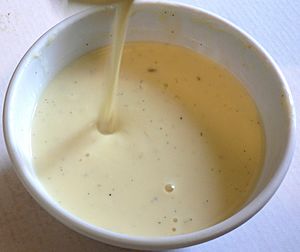Floating island (dessert) facts for kids
 |
|
| Course | Dessert |
|---|---|
| Place of origin | France |
| Main ingredients | meringue (egg whites, sugar and vanilla extract), crème anglaise (egg yolks, vanilla, milk, sugar) |
A floating island (also called île flottante) is a yummy dessert. It's made of light, fluffy meringue that "floats" on a creamy vanilla sauce called crème anglaise.
The meringue is made from whipped egg whites, sugar, and vanilla extract. It's often baked gently in a bain-marie, which is like a water bath. The crème anglaise is a smooth custard made from egg yolks, vanilla, and warm milk, cooked briefly until it thickens.
Contents
What is Œufs à la neige?
Œufs à la neige means "eggs in snow" in French. It's a dessert very similar to floating island. The main difference is how the meringue is shaped. Instead of one big piece, the meringue is in smaller, egg-sized pieces. These pieces are usually poached (gently cooked in liquid) instead of baked.
The History of Floating Island
The idea of a "floating island" dessert has been around for a long time. One of the first mentions in English was in a cookbook from 1747. It was called The Art of Cookery Made Plain and Easy by Hannah Glasse.
Early English Floating Island
Hannah Glasse's recipe for "The Flooting Island" was quite different from today's version. It used whipped cream, wine, and lemon peel. These were layered with thin slices of bread and jelly. The whole thing was piled high with frothy cream. Fruits and candies were placed around the dish. It was often a fancy centerpiece for a table, sometimes with candles.
In 1771, Benjamin Franklin even wrote about having "a floating island" for dinner. An American cookbook from 1847 listed it as a special dessert for Fourth of July celebrations.
French vs. English Versions
Over time, the dessert changed. The historical English version was often a big, fancy creation with cake and jelly. The French version, Île Flottante, was different. Some food experts think today's floating island is more like the old French Île Flottante.
However, early French versions might not have used meringue at all. They sometimes used layers of spongecake or brioche soaked in liquor. These layers were served in a custard sauce or berry puree.
A Winter Wonderland Dessert
In the 1700s, another English recipe by Elizabeth Raffald tried to make the dessert look like a winter scene. She suggested beating egg whites into a strong froth. Then, you would roll a sprig of myrtle (a plant) in it to look like snow.
She also suggested adding candied sweets to look like rocks. Small sheep and swans made of sugar could "pick" at the myrtle. Green sprigs were added to the jelly to complete the winter landscape.
Floating Island in Modern Cookbooks
By 1938, the famous French food encyclopedia Larousse Gastronomique mentioned the dessert. Its writers felt sad that it was served less often because they thought it was "excellent."
The version in Larousse Gastronomique was also different. It used thin slices of stale Savoy biscuits soaked in kirsch (a cherry brandy) and maraschino (a cherry liqueur). These were layered with apricot marmalade. Chopped almonds and currants were used as a garnish. The layers were put together like a cake. It was then frosted with chantilly cream and served with custard or berry puree poured over it.
How to Make Floating Island
Making a floating island involves two main parts: the creamy custard sauce and the light meringue. The meringue "floats" on top of the sauce. Some recipes use a thicker sauce, but usually, the custard is thin enough for the meringue to truly float.
Making the Custard
First, you make the crème anglaise custard. This involves gently cooking milk, sugar, vanilla, and egg yolks. This is often done in a bain-marie. The custard should become thick enough to coat the back of a spoon.
Making the Meringue
To make the meringue, egg whites are beaten with sugar until they are light and fluffy. This mixture is then poured into a mold. Sometimes, the mold is lined with caramelised sugar for extra flavor. The meringue is then steamed in the oven, also in a bain-marie.
Once the meringue is cooked and cooled, the creamy sauce is poured onto a serving plate. The unmolded meringue is then carefully placed on top of the sauce. This makes it look like an island floating on a creamy lake! You can serve this dessert at room temperature or chilled.
See also
 In Spanish: Isla flotante (postre) para niños
In Spanish: Isla flotante (postre) para niños


